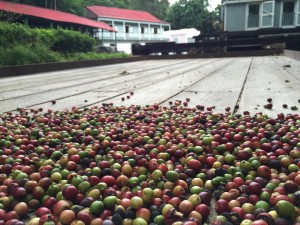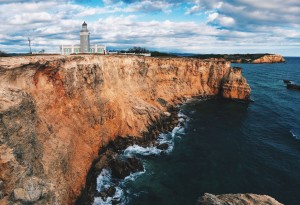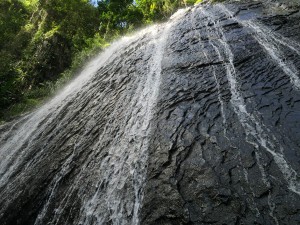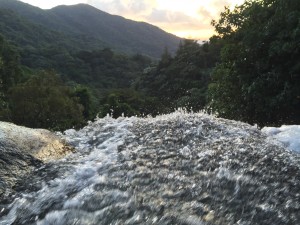When thinking of how to present this blog I thought about what would engage people the most. I think that people respond the best to visuals. The best way to fully experience a place without actually going there is to see videos or pictures of it. In this video I talked about what surprised me most when visiting Puerto Rico: The landscape. I included visuals of the three most extreme landscapes that we observed while traveling abroad. These three extremes were the mountains/rainforest, ocean/beach, and the farming flatlands. I found it interesting how the terrain changes interacted with each other in terms of agriculture. At Martex farms we were taught about how many of the farmers irrigate their fields with the water from the mountains and how the placement of the fields between the mountains and the oceans creates an ideal environment for farming and produces very fertile soil. Overall, I hope to give the open house visitors the best idea possible of what it is like in Puerto Rico. I believe that through strong communication and effective visuals we will be able to do that for our booth visitors.
Author Archives: Austin Green
Puerto Rico Suprises
The past few days in Puerto Rico we’ve had the opportunity to explore the campus of University of Puerto Rico Mayaguez. The campus is beautiful and the roads are lined with palm trees. The university is made up of four colleges: Agricultural Sciences, Engineering, Arts and Sciences, Business Administration. We paid a visit to the Agriculture section of the campus and the site was excellent. The dean of the college of agriculture sat down and talked to us about our trip and the possibility of doing a similar study abroad trip with the students of UPR. I enjoyed seeing the campus and living in apartments similar to what the freshman students here are accustomed to.
Visiting Puerto Rico has been a great learning experience and there has been a number of cultural differences that our group has come across despite this island being part of the United States. The easiest thing to address first is the use of the Spanish language here. My expectation when coming to Puerto Rico was that the English to Spanish ratio would be roughly 2:3. But after spending all this time in the territory, I have noticed that Spanish is used most of the time and is used all of the time unless some tourists like us come along and only know English. Being in Puerto Rico for roughly 10 days now has been like a crash course in Spanish that is more real than any Spanish test I’ve taken in high school. It has required me to go back to my basic Spanish vocabulary and pull out any basic verbs and nouns needed in order to get what I need and go where I need to. Thus far I’ve been able to order food at any place I go to, ask where things are, and greet other people. I’m sure if I ended up studying abroad in a Latin or south American country I would pick up the language and/or study it more beforehand. But what I’ve learned so far will suffice for the things we’ve had to do.
Food is definitely an important part of this culture as it is in any culture. My expectation before arriving in Puerto Rico was that the food would resemble that of Mexico or Spain. We ended up learning firsthand what Puerto Rican food entailed before we even got to the hotel. We visited a food kiosk area that was right off Luqillo beach and were free to choose what Puerto Rican cuisine we would be dining on that night. Almost all of the food stands had the same things: rice, pork, chicken, crab meat, beef, empanadas, tacos, beans, etc. The first night I ended up getting a taco and an empanada. Tacos here are different from the American idea of tacos. Here tacos are generally wrapped completely around the selected meat and then deep fried and can be eaten and held in one hand. Nonetheless it was just as delicious as an American taco. Throughout the trip I’ve gotten to experience other types of Puerto Rican food such as mofongos and toastones. The fruit here tastes fresh and they have mangos that are grown here. Mangos are my favorite fruit when I go out of the country and the ones here do not disappoint. Coffee also seems to be very important to the Puerto Rican people and because it is brewed here for quality, it tastes extremely good. A cultural difference when it comes to Puerto Rican coffee is that it is combined with warm milk instead of the American equivalent of cold creamer. Coffee will never be the same to me now because of how good it was drinking it here.
Puerto Rico vs Illinois
My first time at Puerto Rico has been a blast! I didn’t know what to expect but was pleasantly surprised by the beauty of the island. So far we have visited the national rainforest, a beach, Parque de Bomba, two coffee plantations, a commercial farm, and a large waterfall. My favorite part so far was climbing the waterfall that was located at the base of the mountain that our hotel was built on. It is definitely a memory that could not be made back in Illinois.
After spending a week in Puerto Rico I’ve noticed that two major things which are different from Illinois are the food and the terrain. Some major foods of Puerto Rico are sandwiches, mofongo, empanadas, and rice and beans. I’ve enjoyed trying the new foods in Puerto Rico because the cooks/store owners are usually very nice and the food is phenomenal every single time. Some major foods back in the United States include a wide variety of things but I’ve noticed that the food at home doesn’t taste as fresh as what we have eaten here.
A similarity between Puerto Rico and the US is that a lot of the same food can be found in both places. In Puerto Rico I’ve noticed Chinese food, Mexican food, Italian food, and a lot of American food. I expected some American chain restaurants but not as many as I’ve seen on this trip. A difference in the food of Puerto Rico vs the United States are some of the things that are served. In Puerto Rico you can find rice and beans at almost any typical Puerto Rican food stand. It seems that rice and beans along with plantains and toastones are a very major part of Puerto Rican cuisine. In the United States it seems that rice is not as common of a food among the general population.
Puerto Rico and Illinois have almost no similarities in the climate and terrain. The Puerto Rican terrain ranges from a mountain/rainforest region to a low land desert region. Illinois terrain is generally extremely flat with few areas of high elevation. There is also a huge difference in the climates of the two states. Puerto Rico’s climate consists of a wet and dry season. It’s generally extremely warm in Puerto Rico which plays into the way people manage crops and how they try to control how much shade each plant gets. Illinois consists of hot and cold seasons. This extreme change in temperature plays a huge role in determining when crops must be planted and harvested.
My experience visiting both the coffee plantations and the commercial farm taught me a lot about the specifics of farming in Puerto Rico. I learned about how the run off situation in Puerto Rico is different from what the farmer’s deal with in Illinois. In Puerto Rico, unlike Illinois, some crops can be harvested year round. I think that because Puerto Rico has such a great climate for agriculture, they have a lot of potential in using this to their advantage in terms of their economy.
The trip overall has taught me a lot about agricultural production in a different climate region and it has equipped me with knowledge that I would not have been able to gain in any other class. Along with the visits to various production sites I have been able to experience the different geographical locations on the island such as El Yunque and the beaches. As the trip progresses I hope to obtain better Spanish skills and an even better appreciation for the people and the culture of Puerto Rico.
Project Role
Hi, my name is Austin Green and I am a freshman in Agricultural and Biological Engineering at the University of Illinois.
In this project I think that my role in this project is both a student and a teacher. As a student I will be learning while on the trip, taking in as much information as possible to share during the poster presentation. As a teacher I will communicate both my ideas and information to my classmates and to open house attendees. I will help to make our open house booth a success by contributing my talents and ideas.





